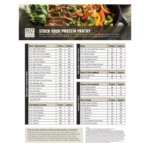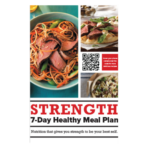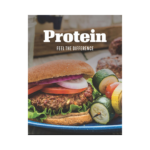Positive Impact of Beef to Support Muscle Gain

Written by Mandy Tyler, M.Ed., RD, CSSD, LD, LAT
As a healthcare practitioner, it can be helpful to have simple nutrition tips that can be shared with patients to support building and maintaining lean muscle mass. Let’s take a look at the role of protein for building muscle. Then we will examine the nutrient composition of beef and explore how lean cuts of beef can help individuals with meeting their protein needs.
Role of Protein for Muscle Building
The current Recommended Daily Allowance (RDA) for protein is 0.8 grams/kg of body weight1. The RDA is recognized as the minimum amount of protein required to prevent deficiency in nearly all healthy individuals. However, when looking at the amount of protein needed to support building and maintaining muscle mass, increased amounts of protein, above the RDA, are commonly recommended2-6.
For athletes and active individuals, protein intakes between 1.2 – 2.0 grams/kg of body weight have been recommended to promote building and maintaining lean muscle mass3. Protein intakes between 1.0-1.5 grams/kg of body weight have been suggested as an appropriate range to support health in older adults. However, intakes of up to 2 grams/kg of body weight may be needed in older adults with severe illness, injury, or malnutrition4,7,8.
What is a High-Quality Protein?
Proteins are composed of individual building blocks called amino acids. There are 20 amino acids the body uses to build muscle, 9 of which are considered to be essential amino acids. The body cannot produce essential amino acids; thus, individuals must consume them in their diets5</sup.
Dietary proteins vary in the types and amounts of amino acids they are composed of. A high-quality, complete protein contains sufficient quantities of all 9 of the essential amino acids. The body can efficiently use high-quality proteins for the synthesis of muscle. Animal and dairy-based sources of protein, such as beef, poultry, pork, seafood, eggs, and milk, are all sources of high-quality protein5.
In contrast to animal proteins, many plant-based sources of protein are deficient in one or more of the essential amino acids, making them incomplete proteins. Thus, when making recommendations on protein intake, it can be helpful to have an understanding of foods that provide a source of high-quality protein.
Timing of Protein Intake to Support Muscle Gain
In addition to recommendations on the total amount of protein an individual should consume in the diet, the distribution of protein intake throughout the day is another important consideration. When individuals consume protein, the rate of muscle protein synthesis increases in the body5,9.
The amount of protein needed to optimally stimulate muscle protein synthesis, appears to be ~ 0.25 grams of protein/kg of body weight or ~25-30 grams9,10,11. While individuals can consume and digest more than this amount of protein in one setting, the rate of muscle protein synthesis does not appear to be further increased by larger intakes of protein9.
To optimally stimulate muscle protein synthesis over the course of the day, individuals should aim to consume protein with meals spaced 3-4 hours apart4,5,12. Unfortunately, in the United States, this is not the way many individuals tend to eat. Adults commonly skew their protein intake towards the end of the day4. Many individuals tend to eat little protein with breakfast, a bit more protein at lunch, and then a protein heavy evening meal.
Therefore, educating patients on easy ways to increase protein intake at meals, particularly at breakfast, is important. The Texas Beef Council’s Strength 7-Day Healthy Meal Plan is a user-friendly resource to share with patients looking for easy ideas on how to increase protein intake with meals.
Nutrition Tip: A general recommendation of consuming ~25-30 grams of protein (0.25 g/kg of body weight) with meals spaced throughout the day would be appropriate for most individuals.
Combining Protein Intake with Workout Routines
Individuals looking to build muscle mass will want to combine protein intake with a well-planned strength training program. Strength training and protein intake both independently stimulate muscle protein synthesis and together have a synergistic effect on the rate of muscle protein synthesis in the body5,13. Following workout sessions, consuming 0.25 g/kg of body weight (~25-30 grams) of a high-quality protein containing all of the essential amino acids is recommended.
The essential amino acid leucine, is of particular interest when it comes to muscle protein synthesis. Research has shown that a threshold amount of leucine (~2-3 grams) is needed to stimulate muscle protein synthesis in the body14.
However, it is important to note, the body cannot build muscle mass with the amino acid leucine alone. To build muscle, all of the essential amino acids must be available in sufficient quantities5,14. Using the analogy of a sports team, leucine acts as the point guard calling the plays for the team. However, to win the game it takes all the players (essential amino acids) on the team contributing in their individual roles.
Nutrition Tip: Following exercise, consume 25-30 grams (0.25 g/kg of body weight) of a high-quality protein containing all of the essential amino acids as well as 2-3 grams of leucine to promote muscle protein synthesis.
Importance of Protein with Age
Consuming adequate protein in the diet is important as individuals age. Aging is associated with a progressive loss of skeletal muscle mass. This decrease in muscle mass can lead to a decline in strength, decreased function and mobility, as well as an increased risk of falls13,15. Therefore, diet and exercise strategies to promote the maintenance of lean muscle mass is critical for older adults.
Compared to younger individuals, older adults require a greater amount of protein to be consumed to optimally stimulate muscle protein synthesis. Older adults should aim to consume 0.4 grams of protein/kg of body weight (~30-40 grams), compared to 0.25 grams/kg of body weight in younger individuals9,13,16.
Combining protein intake with a resistance training program can help further promote the building and maintenance of lean muscle mass in older individuals13. Furthermore, the combination of strength training combined with a high protein diet (1-1.5 grams of protein per day) is recommended in the treatment of primary sarcopenia7.
Nutrition Tip for Older Adults: Consume 30-40 grams of high-quality protein after exercise, as well as with meals, spaced throughout the day12,15.
Protein to Support Weight Loss
In addition to the important role protein plays with building muscle mass, it can also help with the maintenance of lean muscle mass when following a weight loss diet. When individuals are restricting energy intake to lose weight, increasing protein intake can help with the preservation of lean muscle mass as well as promote the loss of fat mass. Higher protein intake may also help promote satiety when following a weight loss diet10,17.
Similar to the discussion above, individuals following a weight loss diet should aim to spread their protein intake throughout the day. A total protein intake of 1.2-1.6 grams per day, with evenly spaced meals providing 25-30 grams of protein may be recommended to those following weight loss diets17,18.
Nutrition Content of Beef
Including lean cuts of beef in the diet can help individuals with meeting their protein needs, as well as increasing their intake of key vitamins and minerals19.
A 3 oz. serving of beef provides20:
- Calories: 173
- Protein: 25 grams
- Fat: 7 grams
- Saturated Fat: 2.8 grams
Protein Content of Beef
Beef is a high-quality, complete protein, containing all 9 essential amino acids in a ratio similar to that of human muscle5,21. A 3-oz serving of beef provides 2.25 grams of leucine as well as all of the essential amino acids20, making it a good choice to include with meals or following a workout to support muscle protein synthesis.
Vitamins and Minerals in Beef
In addition to being a source of high-quality protein, beef also provides many vitamins and minerals that are important for health.
Iron
Beef is a source of iron, which is necessary for the formation of hemoglobin in red blood cells. Iron is also important for physical growth, neurological development, and supporting the integrity of connective tissue. The majority of the iron found in beef is heme iron. Heme iron is more readily absorbed by the body than non-heme iron found in plant-based foods21,22.
Zinc
Beef is also a rich source of the mineral zinc. Zinc has many critical roles in the body. It is important for cell division, protein synthesis, tissue repair, supporting a healthy immune system, and wound healing. The form of zinc found in beef is highly bioavailable and is more readily absorbed by the body than the form of zinc found in plant-based foods21,23.
Selenium
Red meat also contains the essential mineral selenium. In the body, selenium acts as an antioxidant helping prevent the formation of free-radicals and protect cells from damage. Selenium is also important for immune system function and DNA synthesis, as well as for thyroid hormone production21,24.
B Vitamins
Beef is a source of many B Vitamins, including Vitamins B2, B3, B6, and B12. Adequate intake of B Vitamins is important, as they are critical coenzymes necessary for cellular metabolism and energy production.
Vitamin B12 is necessary for the development and functioning of the central nervous system and DNA synthesis, as well as the formation of red blood cells. Meat and other animal-derived foods are the only naturally occurring sources of Vitamin B12 and can be important in helping individuals meet their nutrient needs21,25.
Educating Patients on Lean Cuts of Beef to Support Muscle Gain
In addition to providing guidance on the role of protein to support muscle gain, it can be helpful to educate patients on how to select and prepare lean cuts of beef. Lean cuts of meat have a higher percentage of protein and less fat, making them great choices for individuals to include in their diets21.
Recommendations to share include:
- When selecting beef, look for cuts of meat with the word “loin” or “round” in the name, as these tend to be leaner options (i.e., sirloin, tenderloin, top round, and round tip).
- When purchasing ground beef, select varieties that are 93% lean or leaner.
- Trim excess fat from the outer edge of the cut of meat prior to cooking.
- When cooking ground beef, drain any excess fat off of the beef before using it in the recipe.
- Choose healthier cooking methods such as grilling, roasting, or baking as opposed to deep-frying.
Protein for Muscle Building
In summary, consuming adequate amounts of high-quality protein in the diet is important to support individuals with building and maintaining lean muscle mass. Protein intake should be spread throughout the day with meals and following workouts to optimally stimulate muscle protein synthesis. Individuals can enjoy lean cuts of red meat, which provide high-quality protein as well as vitamins and minerals, as part of a well-balanced diet to help meet their protein needs.
Resources
- National Institute of Health. (n.d.). Nutrient Recommendations and Databases. Ods.od.nih.gov. https://ods.od.nih.gov/HealthInformation/nutrientrecommendations.aspx
- Wolfe, R. R., & Miller, S. L. (2008). The recommended dietary allowance of protein: a misunderstood concept. JAMA, 299(24), 2891–2893. https://doi.org/10.1001/jama.299.24.2891
- Thomas, D. T., Erdman, K. A., & Burke, L. M. (2016). Position of the Academy of Nutrition and Dietetics, Dietitians of Canada, and the American College of Sports Medicine: Nutrition and Athletic Performance. Journal of the Academy of Nutrition and Dietetics, 116<(3), 501–528. https://doi.org/10.1016/j.jand.2015.12.006
- Mamerow, M. M., Mettler, J. A., English, K. L., Casperson, S. L., Arentson-Lantz, E., Sheffield-Moore, M., Layman, D. K., & Paddon-Jones, D. (2014). Dietary protein distribution positively influences 24-h muscle protein synthesis in healthy adults. The Journal of nutrition, 144(6), 876–880. https://doi.org/10.3945/jn.113.185280
- Jäger, R., Kerksick, C. M., Campbell, B. I., Cribb, P. J., Wells, S. D., Skwiat, T. M., Purpura, M., Ziegenfuss, T. N., Ferrando, A. A., Arent, S. M., Smith-Ryan, A. E., Stout, J. R., Arciero, P. J., Ormsbee, M. J., Taylor, L. W., Wilborn, C. D., Kalman, D. S., Kreider, R. B., Willoughby, D. S., Hoffman, J. R., … Antonio, J. (2017). International Society of Sports Nutrition Position Stand: protein and exercise. Journal of the International Society of Sports Nutrition, 14, 20. https://doi.org/10.1186/s12970-017-0177-8
- Volpi, E., Campbell, W. W., Dwyer, J. T., Johnson, M. A., Jensen, G. L., Morley, J. E., & Wolfe, R. R. (2013). Is the optimal level of protein intake for older adults greater than the recommended dietary allowance?. The journals of gerontology. Series A, Biological sciences and medical sciences, 68(6), 677–681. https://doi.org/10.1093/gerona/gls229
- Bauer, J., Morley, J. E., Schols, A. M. W. J., Ferrucci, L., Cruz-Jentoft, A. J., Dent, E., Baracos, V. E., Crawford, J. A., Doehner, W., Heymsfield, S. B., Jatoi, A., Kalantar-Zadeh, K., Lainscak, M., Landi, F., Laviano, A., Mancuso, M., Muscaritoli, M., Prado, C. M., Strasser, F., von Haehling, S., … Anker, S. D. (2019). Sarcopenia: A Time for Action. An SCWD Position Paper. Journal of cachexia, sarcopenia and muscle, 10(5), 956–961. https://doi.org/10.1002/jcsm.12483
- Bauer, J., Biolo, G., Cederholm, T., Cesari, M., Cruz-Jentoft, A. J., Morley, J. E., Phillips, S., Sieber, C., Stehle, P., Teta, D., Visvanathan, R., Volpi, E., & Boirie, Y. (2013). Evidence-based recommendations for optimal dietary protein intake in older people: a position paper from the PROT-AGE Study Group. Journal of the American Medical Directors Association, 14(8), 542–559. https://doi.org/10.1016/j.jamda.2013.05.021
- Moore, D. R., Churchward-Venne, T. A., Witard, O., Breen, L., Burd, N. A., Tipton, K. D., & Phillips, S. M. (2015). Protein ingestion to stimulate myofibrillar protein synthesis requires greater relative protein intakes in healthy older versus younger men. The journals of gerontology. Series A, Biological sciences and medical sciences, 70(1), 57–62. https://doi.org/10.1093/gerona/glu103
- Phillips S. M. (2014). A brief review of higher dietary protein diets in weight loss: a focus on athletes. Sports medicine (Auckland, N.Z.), 44 Suppl 2(Suppl 2), S149–S153. https://doi.org/10.1007/s40279-014-0254-y
- Symons, T. B., Sheffield-Moore, M., Wolfe, R. R., & Paddon-Jones, D. (2009). A moderate serving of high-quality protein maximally stimulates skeletal muscle protein synthesis in young and elderly subjects. Journal of the American Dietetic Association, 109(9), 1582–1586. https://doi.org/10.1016/j.jada.2009.06.369
- Areta, J. L., Burke, L. M., Ross, M. L., Camera, D. M., West, D. W., Broad, E. M., Jeacocke, N. A., Moore, D. R., Stellingwerff, T., Phillips, S. M., Hawley, J. A., & Coffey, V. G. (2013). Timing and distribution of protein ingestion during prolonged recovery from resistance exercise alters myofibrillar protein synthesis. The Journal of physiology, 591(9), 2319–2331. https://doi.org/10.1113/jphysiol.2012.244897
- Wall, B. T., Cermak, N. M., & van Loon, L. J. (2014). Dietary protein considerations to support active aging. Sports medicine (Auckland, N.Z.), 44 Suppl 2(Suppl 2), S185–S194. https://doi.org/10.1007/s40279-014-0258-7
- Zaromskyte, G., Prokopidis, K., Ioannidis, T., Tipton, K. D., & Witard, O. C. (2021). Evaluating the Leucine Trigger Hypothesis to Explain the Post-prandial Regulation of Muscle Protein Synthesis in Young and Older Adults: A Systematic Review. Frontiers in nutrition, 8, 685165. https://doi.org/10.3389/fnut.2021.685165
- Chernoff R. (2004). Protein and older adults. Journal of the American College of Nutrition, 23(6 Suppl), 627S–630S. https://doi.org/10.1080/07315724.2004.10719434
- Churchward-Venne, T. A., Holwerda, A. M., Phillips, S. M., & van Loon, L. J. (2016). What is the Optimal Amount of Protein to Support Post-Exercise Skeletal Muscle Reconditioning in the Older Adult?. Sports medicine (Auckland, N.Z.), 46(9), 1205–1212. https://doi.org/10.1007/s40279-016-0504-2
- Leidy, H. J., Clifton, P. M., Astrup, A., Wycherley, T. P., Westerterp-Plantenga, M. S., Luscombe-Marsh, N. D., Woods, S. C., & Mattes, R. D. (2015). The role of protein in weight loss and maintenance. The American journal of clinical nutrition, 101(6), 1320S–1329S. https://doi.org/10.3945/ajcn.114.084038
- Pasiakos, S. M., Cao, J. J., Margolis, L. M., Sauter, E. R., Whigham, L. D., McClung, J. P., Rood, J. C., Carbone, J. W., Combs, G. F., Jr, & Young, A. J. (2013). Effects of high-protein diets on fat-free mass and muscle protein synthesis following weight loss: a randomized controlled trial. FASEB journal : official publication of the Federation of American Societies for Experimental Biology, 27(9), 3837–3847. https://doi.org/10.1096/fj.13-230227
- Phillips, S. M., Fulgoni, V. L., 3rd, Heaney, R. P., Nicklas, T. A., Slavin, J. L., & Weaver, C. M. (2015). Commonly consumed protein foods contribute to nutrient intake, diet quality, and nutrient adequacy. The American journal of clinical nutrition, 101(6), 1346S–1352S. https://doi.org/10.3945/ajcn.114.084079
- FoodData Central. (n.d.). Fdc.nal.usda.gov. Retrieved May 10, 2023, from https://fdc.nal.usda.gov/fdc-app.html#/food-details/170208/nutrients
- Wyness, L., Weichselbaum, E., O’Connor, A., Williams, E. B., Benelam, B., Riley, H., & Stanner, S. (2011). Red meat in the diet: an update. Nutrition Bulletin, 36(1), 34–77. https://doi.org/10.1111/j.1467-3010.2010.01871.x
- National Institutes of Health. (2022, April 5). Office of Dietary Supplements – Iron. Nih.gov. https://ods.od.nih.gov/factsheets/Iron-HealthProfessional
- National Institutes of Health. (2016). Zinc. Nih.gov; National Institutes of Health. https://ods.od.nih.gov/factsheets/Zinc-HealthProfessional/
- National Institutes of Health. (2017). Office of Dietary Supplements – Selenium. Nih.gov. https://ods.od.nih.gov/factsheets/selenium-healthprofessional/
- National Institutes of Health. (2022, March 9). Office of Dietary Supplements – Vitamin B12. Nih.gov. https://ods.od.nih.gov/factsheets/VitaminB12-HealthProfessional/
- Daley, C. A., Abbott, A., Doyle, P. S., Nader, G. A., & Larson, S. (2010). A review of fatty acid profiles and antioxidant content in grass-fed and grain-fed beef. Nutrition journal, 9, 10. https://doi.org/10.1186/1475-2891-9-10






